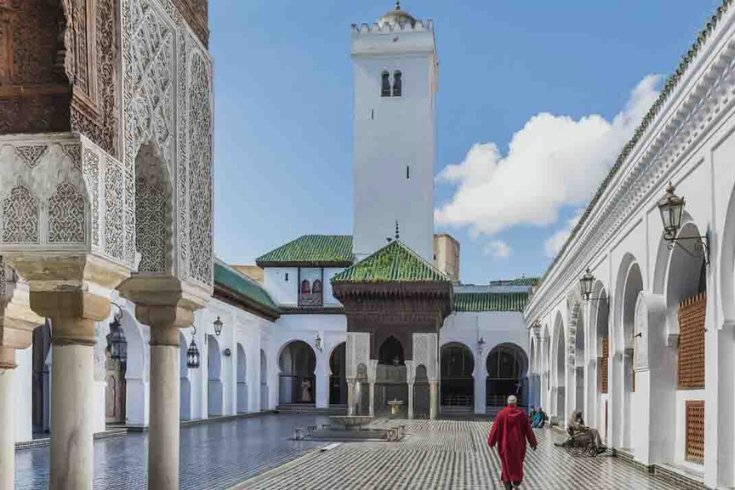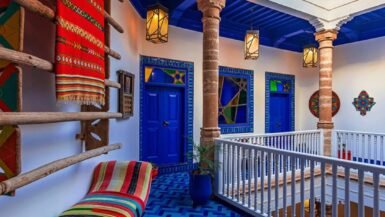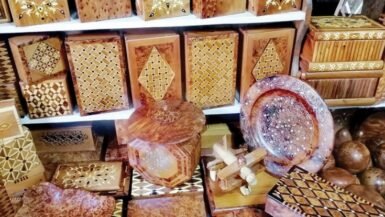At the heart of Fez el-Bali, the Al-Qarawiyyin Mosque stands as a witness to centuries of history, knowledge, and spirituality. It is not only a mosque, but also what is considered the oldest university in the world still in operation today. This comprehensive guide aims to explore the prestigious history of Al-Qarawiyyin Mosque, its unique architecture, its distinctive role as an educational institution, and its religious and cultural importance, while providing practical information to visitors on visit rules and how to reach it at the heart of the UNESCO World Heritage medina.
History of Al-Qarawiyyin Mosque: Centuries of Donation and Expansion
The history of Al-Qarawiyyin Mosque’s construction dates back to the 9th century, and it has undergone considerable developments and expansions under the dynasties that ruled Morocco, making it one of the largest mosques in Africa and among the most important in the Islamic world.
Foundation of the Mosque: Fatima al-Fihri in 859 AD
The story of Al-Qarawiyyin Mosque’s foundation goes back to a pious woman who loved knowledge, Fatima al-Fihri, who had migrated with her family from the city of Kairouan in Tunisia to Fez. After her father’s death, a wealthy merchant, Fatima decided to use her inheritance for a permanent charitable work, thus founding Al-Qarawiyyin Mosque in 859 AD. Historical accounts report that she fasted throughout the entire construction period until the mosque was completed, and that it was simple at the beginning compared to its current size.
Expansions under the Almoravids, Almohads and Marinids (11th-15th centuries)
With the growth of the city of Fez and the increase in its population, the mosque underwent successive expansions under the successive states:
- Under the Almoravids (11th-12th centuries), the mosque was enlarged and the original minaret was added.
- During the Almohad reign, the mosque experienced additional restorations and improvements.
- But the most remarkable expansions took place during the Marinid era (13th-14th centuries), when the mosque reached approximately its current size, and numerous decorations and the distinctive minbar were added.
Architecture of Al-Qarawiyyin Mosque: Beauty and Authentic Islamic Art
The architecture of Al-Qarawiyyin Mosque constitutes a living example of the evolution of Islamic architectural art in Morocco, with its vast courtyards and refined decorations that reflect the craftsmanship of Moroccan artisans through the ages.
General Plan and Size of the Mosque
Al-Qarawiyyin Mosque extends over an area of approximately 8,000 square meters, and is distinguished by its hypostyle design, with more than 270 columns supporting the arches and ceilings. The prayer halls can accommodate more than 20,000 worshippers, making it one of the largest mosques in the Islamic world, a result of successive expansions through the centuries.
Remarkable Architectural Details: the Courtyard, Minaret and Mihrab
- The Courtyard (sahn): The mosque is distinguished by a large open interior courtyard, with at its center a fountain for ablutions decorated with magnificent mosaic decorations.
- Al-Qarawiyyin Minaret: The mosque’s minaret is square-shaped according to the Maghrebi-Andalusian style, and constitutes one of the oldest and most distinctive minarets in Morocco.
- The Mihrab and Minbar: The mihrab is distinguished by its fine stucco decorations, while the wooden minbar is considered a rare work of art from the Marinid era.
Artistic Decorations: Zelliges, Plaster and Wood
Al-Qarawiyyin Mosque abounds with numerous Islamic decorative arts:
- Zelliges (mosaics): Decorate the walls, columns and floors with pieces of colored tiles arranged in complex geometric patterns.
- Stucco carvings: Cover numerous walls and arches with fine stucco carvings including plant motifs, geometric patterns and Quranic inscriptions.
- Woodwork: Manifested in doors and ceilings decorated with relief carvings and sometimes inlaid with ivory and mother-of-pearl.
Among the distinctive elements is also the historic hydraulic clock located outside the mosque, considered one of the oldest hydraulic clocks in the world, although it is rarely in operation today.
Al-Qarawiyyin University: The World’s Oldest Operating University and Beacon of Knowledge
In addition to being a mosque for prayer, Al-Qarawiyyin gained its most remarkable worldwide fame as a historic educational center, recognized as the world’s oldest operating university, predating European universities by several centuries.
Recognition as the World’s Oldest University
Al-Qarawiyyin Mosque has obtained recognition from UNESCO and the Guinness Book of Records as the world’s oldest continuous educational institution, with studies having begun there since the 9th century. This predates the oldest European universities such as the University of Bologna (1088) and Oxford (1096) by more than two centuries.
Study Programs and Eminent Scholars and Graduates
Al-Qarawiyyin University was famous for teaching Islamic and scientific sciences:
- Religious sciences: Quran, Hadith, Maliki jurisprudence, exegesis.
- Arabic language and its literature: grammar, morphology, rhetoric.
- Rational sciences: logic, philosophy, mathematics, astronomy, medicine.
Among the most eminent scholars associated with Al-Qarawiyyin are the scholar Ibn Khaldun, founder of sociology, the philosopher Ibn Rushd (Averroes), the thinker Ibn Maimonides, and other scholars who enriched human civilization through their knowledge and works.
Al-Qarawiyyin’s Historic Library and its Manuscripts
Al-Qarawiyyin’s library is considered one of the oldest libraries in the world, and houses a precious collection of rare manuscripts, some dating from the 9th century. The manuscripts include ancient copies of the Quran, books on medicine, astronomy, mathematics and philosophy. The library has undergone complete restoration in recent years, and part of it has become accessible for visits under certain conditions.
Religious and Cultural Importance of Al-Qarawiyyin Mosque in Fez
Al-Qarawiyyin Mosque occupies a prestigious place in the religious and cultural heart of Morocco:
- It is considered the most important mosque in the city of Fez, and one of the most important mosques in Morocco.
- It represents a symbol of Fez’s position as the spiritual and scientific capital of the Kingdom of Morocco.
- It formed for centuries a center for the Maliki school, the dominant school in Morocco and North Africa.
- It represents the continuity of worship and teaching for more than 1,160 years without interruption.
Visiting Al-Qarawiyyin Mosque: Practical Guide and Entry Rules
Al-Qarawiyyin Mosque is an important monument for visitors to Fez, but it is essential to know the specific entry rules to respect the sanctity of the place and understand how to benefit from your visit.
Entry into the Mosque for Non-Muslims
Please note that entry into the main building of Al-Qarawiyyin Mosque (prayer halls and interior courtyard) is reserved for Muslims only. However, non-Muslims can observe parts of the mosque’s interior courtyard from certain doors open to the street, such as the door near the Attarine madrasa. It is also possible to see the minaret and exterior walls from the surrounding streets, or from the terraces of nearby cafes and restaurants that offer views of the mosque.
Entry for Muslim Worshippers
Muslims can enter the mosque to pray during the five daily prayers, and particularly Friday prayer which sees heavy attendance. It is preferable to enter the mosque with calm and respect, following the usual rules of mosques.
Location of the Mosque and How to Get There in Fez el-Bali
Al-Qarawiyyin Mosque is located at the heart of the medina (Fez el-Bali), surrounded by traditional souks and narrow alleys. It is located near other important monuments such as the Attarine madrasa and the mausoleum of Moulay Idriss II. To get there, you can:
- Enter through Bab Bou Jeloud (the blue gate) and walk through the souks for 15-20 minutes.
- Follow the signs indicating “Al-Qarawiyyin Square” or “Al-Qarawiyyin Quarter”.
- Use a local tourist guide to avoid getting lost in the interwoven alleys.
Best Time to Visit and Discover the Cuisine of the City of Fez
It is preferable to visit the area around Al-Qarawiyyin Mosque during daylight hours, when visibility is good and the surrounding souks are active. After the visit, you can enjoy the dishes of traditional Fez cuisine in the surrounding restaurants, famous for their tagines, pastillas and harira.
Respect for the Sanctity of the Place
When visiting the area around the mosque, please:
- Wear modest clothing covering shoulders and knees.
- Maintain calm and respect the worshippers.
- Ask permission before taking photos, especially of people.
- Do not interfere with the movement of worshippers entering and leaving the mosque.
Monuments Near Al-Qarawiyyin Mosque
Attarine Madrasa
Located a few steps from one of the entrances to Al-Qarawiyyin Mosque, this is a Marinid architectural masterpiece that can be visited with a ticket. From there, you can see parts of the courtyard of Al-Qarawiyyin Mosque.
Mausoleum of Moulay Idriss II
Tomb of the founder of the city of Fez, located near Al-Qarawiyyin Mosque, considered one of the most sacred places in the city.
Bab Bou Jeloud
The main gate of the old city, known for its distinctive blue and green colors, which serves as a starting point to reach Al-Qarawiyyin Mosque.
Fez Souks and Traditional Fez Products
Around the mosque are specialized traditional souks, from the coppersmiths’ souk (Seffarine) to the perfumers’ souk (Attarine) and the wood souk, where you can buy authentic traditional Fez products such as zelliges, carpets and copper utensils.
Accommodation Options in Fez
In the area around Al-Qarawiyyin Mosque, several accommodation options in Fez are available, from traditional riads to modern hotels, making it easy for visitors to enjoy their proximity to this historic monument.
Other Exploration Excursions in Morocco
After visiting Al-Qarawiyyin Mosque, visitors can explore other Moroccan cities such as Rabat, the administrative capital of the kingdom, and Essaouira, a coastal city famous for its ramparts and historic ports, and red Marrakech with its famous Jemaa el-Fna square.
Tourist Places in Moulay Yacoub
Near Fez, you can visit the tourist places of Moulay Yacoub and enjoy the hot springs and magnificent natural landscapes.
Fez el-Jadid
You can also visit Fez el-Jadid, the quarter founded by the Marinids in the 13th century, which houses the royal palace and the historic Jewish quarter.
Additional Information Sources
For more detailed information on the mosque’s history and its academic importance, you can consult the digital library of Al-Qarawiyyin University and the Britannica Encyclopedia on Al-Qarawiyyin Mosque.
Conclusion: Al-Qarawiyyin Mosque… The Eternal Spiritual and Scientific Heritage of Fez
Al-Qarawiyyin Mosque remains one of the most important historical and spiritual monuments not only in Fez, but in the entire Islamic world. It embodies the story of an exceptional achievement that began with the initiative of a pious Muslim woman, and evolved through the centuries to become a beacon of knowledge, learning and worship.
Although entry into the mosque is limited for non-Muslims, discovering its history and admiring its architecture from the outside, as well as understanding its central role in the history of Fez and Islamic civilization, remains a rich and indispensable experience for any visitor to the medina.
We invite you to visit the area of Al-Qarawiyyin Mosque and discover the splendor of this exceptional monument from the accessible viewpoints, while respecting the sanctity of the place and the visit rules. Don’t forget to share your experience and impressions of this historic building in the comments.






Leave a reply